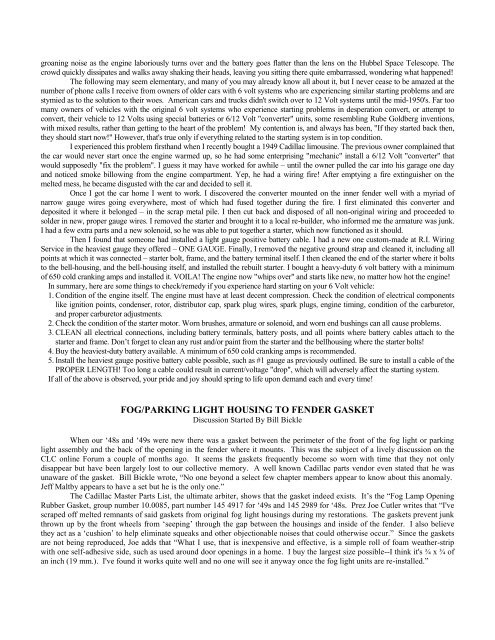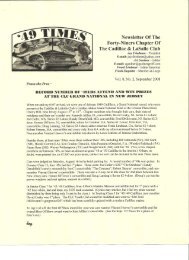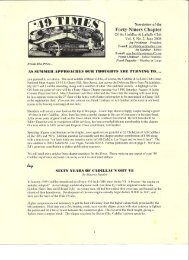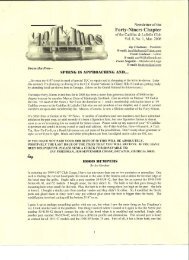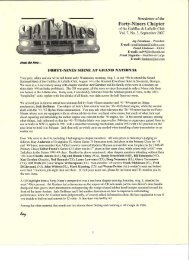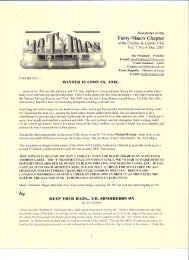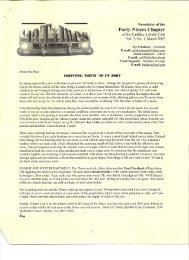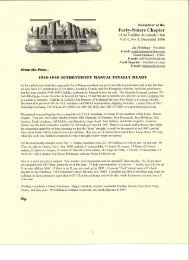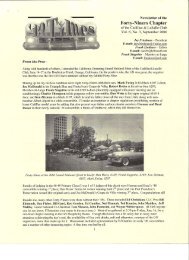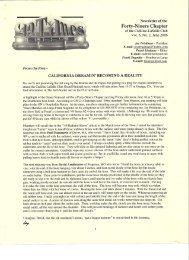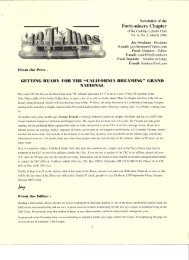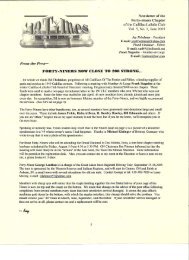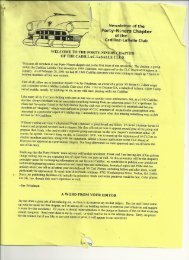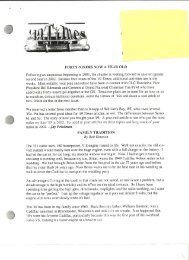Create successful ePaper yourself
Turn your PDF publications into a flip-book with our unique Google optimized e-Paper software.
groaning noise as the engine laboriously turns over and the battery goes flatter than the lens on the Hubbel Space Telescope. The<br />
crowd quickly dissipates and walks away shaking their heads, leaving you sitting there quite embarrassed, wondering what happened!<br />
The following may seem elementary, and many of you may already know all about it, but I never cease to be amazed at the<br />
number of phone calls I receive from owners of older cars with 6 volt systems who are experiencing similar starting problems and are<br />
stymied as to the solution to their woes. American cars and trucks didn't switch over to 12 Volt systems until the mid-1950's. Far too<br />
many owners of vehicles with the original 6 volt systems who experience starting problems in desperation convert, or attempt to<br />
convert, their vehicle to 12 Volts using special batteries or 6/12 Volt "converter" units, some resembling Rube Goldberg inventions,<br />
with mixed results, rather than getting to the heart of the problem! My contention is, and always has been, "If they started back then,<br />
they should start now!" However, that's true only if everything related to the starting system is in top condition.<br />
I experienced this problem firsthand when I recently bought a 1949 Cadillac limousine. The previous owner complained that<br />
the car would never start once the engine warmed up, so he had some enterprising "mechanic" install a 6/12 Volt "converter" that<br />
would supposedly "fix the problem". I guess it may have worked for awhile – until the owner pulled the car into his garage one day<br />
and noticed smoke billowing from the engine compartment. Yep, he had a wiring fire! After emptying a fire extinguisher on the<br />
melted mess, he became disgusted with the car and decided to sell it.<br />
Once I got the car home I went to work. I discovered the converter mounted on the inner fender well with a myriad of<br />
narrow gauge wires going everywhere, most of which had fused together during the fire. I first eliminated this converter and<br />
deposited it where it belonged – in the scrap metal pile. I then cut back and disposed of all non-original wiring and proceeded to<br />
solder in new, proper gauge wires. I removed the starter and brought it to a local re-builder, who informed me the armature was junk.<br />
I had a few extra parts and a new solenoid, so he was able to put together a starter, which now functioned as it should.<br />
Then I found that someone had installed a light gauge positive battery cable. I had a new one custom-made at R.I. Wiring<br />
Service in the heaviest gauge they offered – ONE GAUGE. Finally, I removed the negative ground strap and cleaned it, including all<br />
points at which it was connected – starter bolt, frame, and the battery terminal itself. I then cleaned the end of the starter where it bolts<br />
to the bell-housing, and the bell-housing itself, and installed the rebuilt starter. I bought a heavy-duty 6 volt battery with a minimum<br />
of 650 cold cranking amps and installed it. VOILA! The engine now "whips over" and starts like new, no matter how hot the engine!<br />
In summary, here are some things to check/remedy if you experience hard starting on your 6 Volt vehicle:<br />
1. Condition of the engine itself. The engine must have at least decent compression. Check the condition of electrical components<br />
like ignition points, condenser, rotor, distributor cap, spark plug wires, spark plugs, engine timing, condition of the carburetor,<br />
and proper carburetor adjustments.<br />
2. Check the condition of the starter motor. Worn brushes, armature or solenoid, and worn end bushings can all cause problems.<br />
3. CLEAN all electrical connections, including battery terminals, battery posts, and all points where battery cables attach to the<br />
starter and frame. Don‘t forget to clean any rust and/or paint from the starter and the bellhousing where the starter bolts!<br />
4. Buy the heaviest-duty battery available. A minimum of 650 cold cranking amps is recommended.<br />
5. Install the heaviest gauge positive battery cable possible, such as #1 gauge as previously outlined. Be sure to install a cable of the<br />
PROPER LENGTH! Too long a cable could result in current/voltage "drop", which will adversely affect the starting system.<br />
If all of the above is observed, your pride and joy should spring to life upon demand each and every time!<br />
FOG/PARKING LIGHT HOUSING TO FENDER GASKET<br />
Discussion Started By Bill Bickle<br />
When our ‗48s and ‗49s were new there was a gasket between the perimeter of the front of the fog light or parking<br />
light assembly and the back of the opening in the fender where it mounts. This was the subject of a lively discussion on the<br />
CLC online Forum a couple of months ago. It seems the gaskets frequently become so worn with time that they not only<br />
disappear but have been largely lost to our collective memory. A well known Cadillac parts vendor even stated that he was<br />
unaware of the gasket. Bill Bickle wrote, ―No one beyond a select few chapter members appear to know about this anomaly.<br />
Jeff Maltby appears to have a set but he is the only one.‖<br />
The Cadillac Master Parts List, the ultimate arbiter, shows that the gasket indeed exists. It‘s the ―Fog Lamp Opening<br />
Rubber Gasket, group number 10.0085, part number 145 4917 for ‗49s and 145 2989 for ‗48s. Prez Joe Cutler writes that ―I've<br />
scraped off melted remnants of said gaskets from original fog light housings during my restorations. The gaskets prevent junk<br />
thrown up by the front wheels from ‗seeping‘ through the gap between the housings and inside of the fender. I also believe<br />
they act as a ‗cushion‘ to help eliminate squeaks and other objectionable noises that could otherwise occur.‖ Since the gaskets<br />
are not being reproduced, Joe adds that ―What I use, that is inexpensive and effective, is a simple roll of foam weather-strip<br />
with one self-adhesive side, such as used around door openings in a home. I buy the largest size possible--I think it's ¾ x ¾ of<br />
an inch (19 mm.). I've found it works quite well and no one will see it anyway once the fog light units are re-installed.‖


